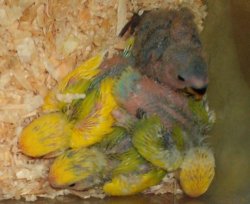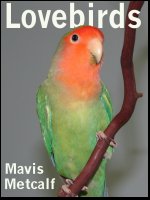Breeding Lovebirds

Lovebirds can be wonderful pets. In order for them to be wonderful pets though, they have to get a great start on life. A Lovebird breeder has quite a job ahead because these birds can be very unpredictable.
One of the first things you have to do is to make sure you have a male and a female Lovebird. A pair of males and a pair of females will both bond and act the same as a true pair that consists of a male and a female.
There are a couple of things that will help you make a guess as to whether you have a male or a female, but there are only slight differences & this is not a guaranteed method of sexing Lovebirds. A hen is usually a little broader and often perches with her legs a little further apart than a cock does. Her pelvic bones can be a little further apart and you may be able to feel the difference by gently feeling with your little finger. If you really want to know before letting your birds bond, you might want to send a sample of blood to a company that provides a DNA service.
A second problem is finding a male and a female that like each other. Lovebirds are often fondly referred to as the “pitbull of birds” and for good reason. One bird (usually the hen) can turn on its mate without warning and the owner returns home one day to find one dead bird in the cage.
Once you are successful in finding the right pair that is at least a year old (better yet a year and a half old) you should be rewarded with some clutches of healthy baby Lovebirds.
The adult birds have to be fed a good diet consisting of a seed/ pellet base along with fruits and vegetables. Sprouted seeds contain much more nutrition than dry seeds and you may wish to add some of those to their diet. Hard boiled eggs that are mashed up with the eggs shells provides good nutrition. You can pick up a box of egg food (also known as nestling egg food or nestling food) to have on hand to mix with the eggs or to feed dry. This is something that the parent birds will feed their babies and before nesting the male will use this to feed his mate.
I like to hang the nestbox outside the cage with an entrance either cut through the bars of the cage or using a cage that has a built in nesting door. This will give you easier access to check for progress and keep track as to when eggs are laid & when the babies hatch.
Lovebirds build nests before laying eggs. It is fascinating to watch them place the nesting material into their feathers to carry it into the nestbox. They are usually not too fussy about what they use and will cut newspaper or paper towels into strips or carry grasses & weeds (be sure that no pesticides have been used) or use their own feathers. Fresh water must be constantly in supply.
Once the nest is finished, it is usually not long before eggs are laid. The hen will lay an egg every second day until she has 4 to 6 eggs in her nest. She may not start incubating them until the 2nd or 3rd egg has been laid so that the first babies should hatch fairly close together. The first egg will normally hatch about 24 days after the hen starts to incubate depending on how tight she sits.
You will be amazed at how quickly the food disappears once there are babies to be fed. Keep a close watch on the food dishes to make sure there is always a constant supply as babies are non stop eaters.
If you plan on handfeeding these babies, the time to take them from the parents is approximately 2 weeks of age. This is the time that they will accept food willingly yet they have had time with their parents to give them a good start.

If you have never handfed a bird, you should not start without watching and learning from an experienced breeder. It is much too easy for an inexperienced handfeeder to make a mistake that could cause the death of a tiny baby.
Lovebird babies wean at approximately 8 weeks of age, with some earlier and some later. They should be weaned onto a good variety of foods. The babies should be handled a lot to ensure that they will be wonderful pets for someone. Lovebirds that are not handfed AND handled often do not make as good a pet as the ones that have had both.
After many years of Lovebird ownership, I have decided to write an e-book about these wonderful birds.

I found some wonderful parrot t-shirts at Choice Shirts
One of the first things you have to do is to make sure you have a male and a female Lovebird. A pair of males and a pair of females will both bond and act the same as a true pair that consists of a male and a female.
There are a couple of things that will help you make a guess as to whether you have a male or a female, but there are only slight differences & this is not a guaranteed method of sexing Lovebirds. A hen is usually a little broader and often perches with her legs a little further apart than a cock does. Her pelvic bones can be a little further apart and you may be able to feel the difference by gently feeling with your little finger. If you really want to know before letting your birds bond, you might want to send a sample of blood to a company that provides a DNA service.
A second problem is finding a male and a female that like each other. Lovebirds are often fondly referred to as the “pitbull of birds” and for good reason. One bird (usually the hen) can turn on its mate without warning and the owner returns home one day to find one dead bird in the cage.
Once you are successful in finding the right pair that is at least a year old (better yet a year and a half old) you should be rewarded with some clutches of healthy baby Lovebirds.
The adult birds have to be fed a good diet consisting of a seed/ pellet base along with fruits and vegetables. Sprouted seeds contain much more nutrition than dry seeds and you may wish to add some of those to their diet. Hard boiled eggs that are mashed up with the eggs shells provides good nutrition. You can pick up a box of egg food (also known as nestling egg food or nestling food) to have on hand to mix with the eggs or to feed dry. This is something that the parent birds will feed their babies and before nesting the male will use this to feed his mate.
I like to hang the nestbox outside the cage with an entrance either cut through the bars of the cage or using a cage that has a built in nesting door. This will give you easier access to check for progress and keep track as to when eggs are laid & when the babies hatch.
Lovebirds build nests before laying eggs. It is fascinating to watch them place the nesting material into their feathers to carry it into the nestbox. They are usually not too fussy about what they use and will cut newspaper or paper towels into strips or carry grasses & weeds (be sure that no pesticides have been used) or use their own feathers. Fresh water must be constantly in supply.
Once the nest is finished, it is usually not long before eggs are laid. The hen will lay an egg every second day until she has 4 to 6 eggs in her nest. She may not start incubating them until the 2nd or 3rd egg has been laid so that the first babies should hatch fairly close together. The first egg will normally hatch about 24 days after the hen starts to incubate depending on how tight she sits.
You will be amazed at how quickly the food disappears once there are babies to be fed. Keep a close watch on the food dishes to make sure there is always a constant supply as babies are non stop eaters.
If you plan on handfeeding these babies, the time to take them from the parents is approximately 2 weeks of age. This is the time that they will accept food willingly yet they have had time with their parents to give them a good start.

If you have never handfed a bird, you should not start without watching and learning from an experienced breeder. It is much too easy for an inexperienced handfeeder to make a mistake that could cause the death of a tiny baby.
Lovebird babies wean at approximately 8 weeks of age, with some earlier and some later. They should be weaned onto a good variety of foods. The babies should be handled a lot to ensure that they will be wonderful pets for someone. Lovebirds that are not handfed AND handled often do not make as good a pet as the ones that have had both.
After many years of Lovebird ownership, I have decided to write an e-book about these wonderful birds.

I found some wonderful parrot t-shirts at Choice Shirts
This site needs an editor - click to learn more!
You Should Also Read:
Lovebirds
Lovebird Links
Birds Site Map
Related Articles
Editor's Picks Articles
Top Ten Articles
Previous Features
Site Map
Content copyright © 2023 by Mavis Metcalf. All rights reserved.
This content was written by Mavis Metcalf. If you wish to use this content in any manner, you need written permission. Contact
BellaOnline Administration
for details.


